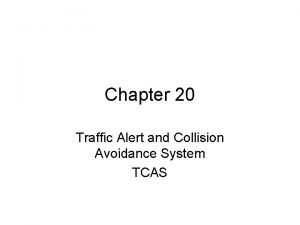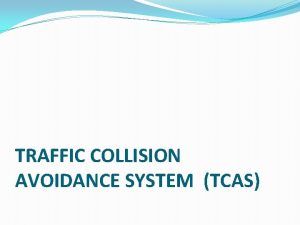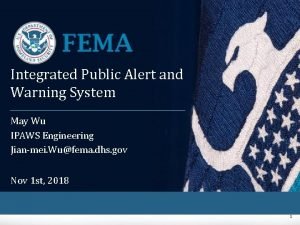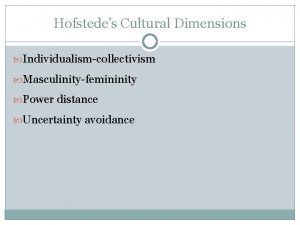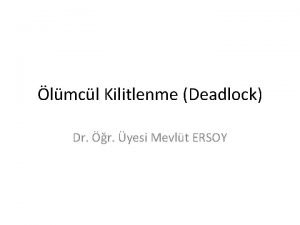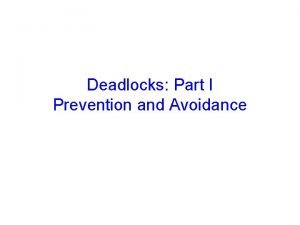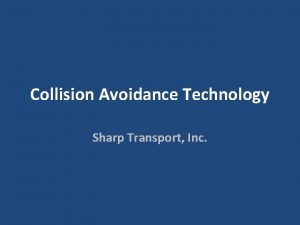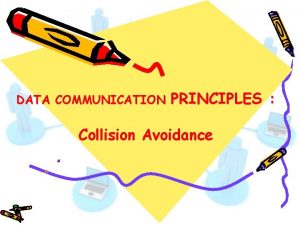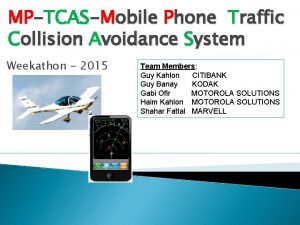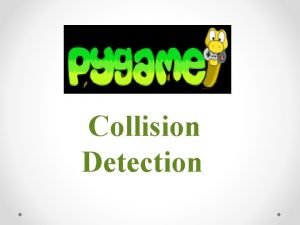Chapter 20 Traffic Alert and Collision Avoidance System









- Slides: 9

Chapter 20 Traffic Alert and Collision Avoidance System TCAS

TCAS Overview • • • The heart of the TCAS system is the transponder. Once every second the transponder sends out a similar interrogation that is sent to the ATC surveillance radar. If another aircraft is within range, it will respond to the interrogation, the first aircraft will measure the time difference to compute the range of the other aircraft. Aircraft with Mode C transponders will respond with altitude information. Aircraft with Mode S transponders will respond with address information. Aircraft with the old ATCRBS transponders do not have TCAS, however TCAS aircraft will receive a TA (threat advisory) when those aircraft get within range. Because TCAS operates aircraft-to-aircraft, it is not dependant on ground stations. To decide if an airplane is on a collision course, the TCAS processor will look at “range rate” which tells the rate at which distance is changing. If the “range rate” is constant, that means the aircraft are on a collision course. Because aircraft operate at different speeds and performance, allowance has to be made. Tau, a Greek letter is what represents that allowance, which is done by measuring distance and closing rate and adjusts its warning times to compensate. The TCAS system issues 2 types of alerts: a TA which is a threat advisory that alerts the pilot that another aircraft is close enough to be a potential threat; a RA is a resolution advisory that means the other aircraft IS a threat (30 seconds to a possible collision) and issues commands to evade a collision.

TCAS on a Radar Display Here is TCAS displayed on a Radar Display, for aircraft equipped with EFIS. If a TA is issued, an audible warning will be a voice saying “Traffic” If an RA is issued, an audible warning will be a voice saying to climb or descend. The system shown is TCAS II, required for large aircraft, which issues both a TA or an RA. TCAS II needs a Mode S transponder to operate. TCAS I is for GA and only issues TA’s.

TCAS on Vertical Speed Indicator • For aircraft not equipped with EFIS, TCAS is display on the Vertical Speed Indicator. • The VSI on the right is showing an RA. • The red arc indicates the area to avoid, the pilot always shoots for the green arc. • In this example, the airplane is descending at about 3000 feet per minute.

TCAS Voice Warnings

TCAS System Block Diagram • • • The system shown is a TCAS II system. There is both a top and bottom transponder antenna to insure full coverage. The computer processes large amounts of information: target tracking, threat assessment, visual and aural advisories, escape maneuvers and coordinated maneuvers between aircraft on a collision course. Maneuver coordination is accomplished each aircraft sending out coordinated interrogations once per second. Non TCAS equipped aircraft will not be able to perform maneuver coordination and only a TA will be issued. These interrogations broadcast the “intent”, the escape command issued, so that the other aircraft won’t issue the same command, for instance to climb, thus avoiding a collision.

Overload Prevention • • • In congested areas near large airports, there is a problem of too many TCAS alerts. To prevent this from occurring, the “whisper-shout” technique was developed. The “whisper” transmits interrogations at low power, about 2 watts when the aircraft is in cruise; only the closest aircraft with the most sensitive transponders hear it and reply. Next, the transponder increases power to trigger replies from aircraft slightly further away; at the same time it sends a suppression pulse which silences the first set of transponders and prevents their replies. In rapid steps, the interrogations increase in power until they are “shouting” at 250 watts. These high-level signals now reach aircraft at the outer edge of the range. Then the system returns to “whisper” again, the cycle is repeated once per second. This cycle allows for only small groups of replies to get through at any one time, effectively “buffering” the system. The directional antenna also divides a full circle into 90° quadrants and limits replies to the active quadrant, further “buffering” the system.

TCAS System Components • • • The control panel is for both TCAS and the Transponder and selects the functions. There are the top and bottom transponder antennas. The Mode S transponder allows for TCAS II operation. The TCAS processor computes aircraft speed, closure rate, etc and issues the appropriate command. This example shows the display on the Weather Radar Display as well as the Vertical Speed Indicators. Top and Bottom directional antennas allow for directional interrogation which electrically rotates 90° at a time which allows for sensing of bearing of the threat and buffering.

Review Q & A Chapter 20 TCAS 20. 1 A TCAS aircraft transmits an interrogation once per ____. Answer: second. 20. 2 How does an intruder aircraft with an ATCRBS (early type) transponder reply to TCAS interrogation? Answer: Only a TA 20. 3 How does an intruder aircraft with a Mode S transponder reply to TCAS interrogations? Answer: Both a TA and RA 20. 4 How does TCAS determine the direction of a threat? Answer: From its directional antenna 20. 5 How does TCAS determine the distance of a threat? Answer: By using Tau and using the range rate. 20. 6 How does TCAS determine whether the other aircraft is a threat? Answer: By using range rate 20. 7 What is the concept of “Tau”? Answer: Compensation for varied speeds and performance 20. 8 Name the 2 kinds of warnings issued by TCAS. Answer: TA (Threat Advisory) and RA (Resolution Advisory). 20. 9 Does a Threat Advisory (TA) command the pilot to maneuver out of the way? Answer: No. 20. 10 What does a Resolution Advisory (RA) do? Answer: Issues evasive maneuvers 20. 11 If 2 TCAS aircraft are closing, what prevents them from climbing, and flying into each other? Answer: Coordinated Resolution Advisories 20. 12 What is the technique of “whisper-shout”? Answer: Buffering of replies to prevent alert overload 20. 13 How does the directional antenna reduce the number of replies for each interrogation? Answer: By only responding to interrogations in the active quadrant.
 Collision avoidance system block diagram
Collision avoidance system block diagram Tcas collision avoidance
Tcas collision avoidance Inbound traffic vs outbound traffic
Inbound traffic vs outbound traffic All traffic solutions traffic cloud
All traffic solutions traffic cloud Integrated public alert and warning system
Integrated public alert and warning system Low and high uncertainty avoidance
Low and high uncertainty avoidance Laray m. barna (1997)
Laray m. barna (1997) Deadlock prevention or avoidance
Deadlock prevention or avoidance Deadlock detection prevention and avoidance
Deadlock detection prevention and avoidance Deadlock prevention and avoidance
Deadlock prevention and avoidance
